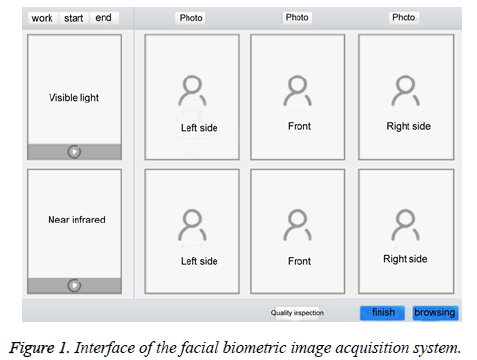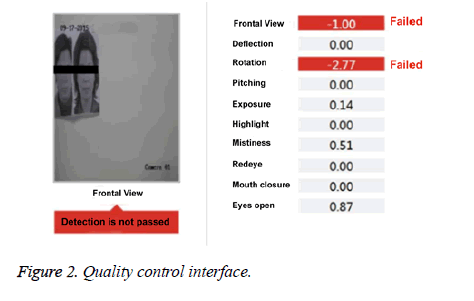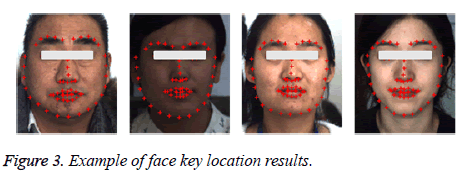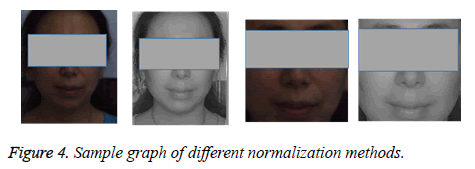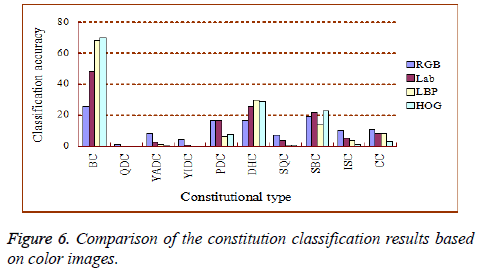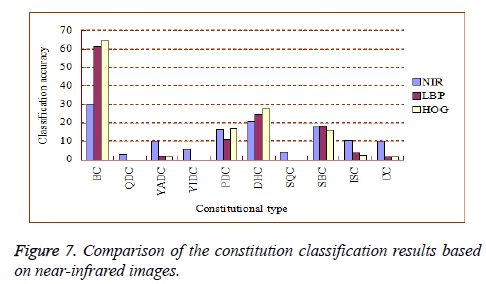Research Article - Biomedical Research (2017) Volume 28, Issue 10
Research on TCM constitution classification based on facial color and texture features
Shujuan Hou1#, Jian Zhang2#, Pin Li1, Junwen Han1, Haiqiang Yao1, Ranran Sun1,Lingru Li1, Qi Wang1*, Ziqing Li3 and Zheng Lei31School of Basic Medical Sciences, Beijing University of Chinese Medicine, Beijing, PR China
2Beijing Traditional Chinese Medical Hospital, Beijing, PR China
3Institute of Automation, Chinese Academy of Science, Beijing, PR China
#These authors contributed equally to this work
- *Corresponding Author:
- Qi Wang
School of Basic Medical Sciences
Beijing University of Chinese Medicine, PR China
Accepted on March 6, 2017
Abstract
Objective: This research was conducted to explore the possible correlation between Traditional Chinese Medicine (TCM) constitutions and facial features, and improve the accuracy of constitution classification.
Methods: Automatic face detection and key point positioning were adopted to automatically detect the human face area in collected images, which were further cut into a standard size. We extracted the color and texture features of the facial image using the linear discriminant analysis classifier and studied its contribution to the classification of a constitution. The color features included RGB color space and Lab space, and the texture features included the Local Binary Pattern (LBP) and Histogram of Oriented Gradients (HOG).
Results: (1) A higher classification was achieved using the Lab color space than RGB. (2) LBP, HOG and other texture features were typically better than the color features (RGB and Lab) for achieving a higher classification. LBP. (3) Although the near-infrared image was more robust for illumination changes, it lost important color information. (4) The classification accuracy of the BC was relatively high, followed by the DHC, PDC, SBC and CC. Because of the low number of image samples, the classification accuracy of the YADC, YIDC, SQC, and QDC was typically low.
Conclusion: Facial color and texture features can assist in the classification of TCM constitutions.
Keywords
TCM constitution, Facial features, Face recognition.
Introduction
The discussion of human constitutions dates back to Hippocrates (460 BC-377 BCE), an ancient Greek physician, and “Huang Di Nei Jing” (approximately 200 BCE) during the Qin and Han dynasties; however, neither a universal standard nor extensive medical application of human constitution has been achieved in the past 2,000 years [1]. Traditional Chinese medicine (TCM) constitution theory was founded in the 1970s on the basis of the “Huang Di Nei Jing” constitution classification of Chinese people and related research. TCM constitution refers to the comprehensive and stable feature of physiological structure and function, and psychological state, which develop along with the process of life on the basis of prenatal endowment and postnatal acquirement. It is the specific feature of the human body developed to adapt to the natural and social environment, and manifests as individual differences in structure, function, metabolism, response to external stimuli, susceptibility to certain pathogens and diseases, and tendencies in the progress of diseases. Its feature of individual difference, group convergence, relative stability and dynamic variability is closely related to health and disease development. Therefore, constitution classification can provide a prediction of the future development of certain diseases, and intervention for a biased constitution can act accordingly as a way of prevention [2,3].
Presently, available constitution identification methods are the Constitution in Chinese Medicine Questionnaire and computer software that is programmed based on it. In these methods, inquiry is the main means of diagnosis because, to date, other diagnostic techniques and biological feature detection have not been fully applied to this area. Therefore, it remains an urgent need in TCM constitution theory to obtain more objective, accurate and fast results using modern information technology and combining the subjects of computer science, medical engineering and other disciplines. Thus, more effective and accurate advice can be given to promote health management.
Inspection ranks as the first among the four examinations in TCM. Inspection of the face, an important aspect of the inspection method, involves the observation of patients’ vitality, complexion, body structure and posture to evaluate their exterior mental state and flourishing or withering of qi and the blood of internal organs. In a healthy condition, the human body benefits from abundant qi and blood, and a harmonious relation among the internal organs, and this can be reflected in a normal complexion. If disharmony of qi, blood or internal organs occurs, it manifests in the facial complexion [4]. In TCM constitution classification, observation and analysis of complexion, facial oil, and macules and papules can improve accuracy for constitution classification. Therefore, in this study, the relation between facial images and constitution classification is combined and researched to provide a reference for constitution classification based on facial features.
Methods
Image collection
Face images and motion videos of human faces were collected using a facial biometric image acquisition system developed by the Institute of Automation at the Chinese Academy of Sciences. This system allows playback, real-time browsing and quality evaluation of the collected images to ensure the images’ reliability for future analysis. The collecting interface is shown in Figure 1. The system can adjust and control the light of the face collection window. Visible light adjustment includes two channels so that the light can be shone evenly on the face. Near-infrared mainly adjusts the exposure based on the field situation.
Face images were all collected indoors.
Quality control
After the face image was collected, we detected the quality of the photographs. If there were some errors, such as posture and ambient light, we retook the photos until the detection test passed. The quality control interface is shown in Figure 2.
Face detection
According to the multi-channel detection of facial features, color space, gradient and directional gradient histograms were added to enrich the expression. Down-sampling was used on images collected using multi-channel methods, and the collection, directly composed of pixels, was chosen to facilitate future subsequent feature selection. In this study, 10 channel types were selected, which were LUV color space (three channels), gradient (one channel) and six-direction gradient histogram (six channels). In the selection of the classifier learning algorithm, we chose the Viola-Jones framework used in the AdaBoost lifting algorithm. However, because the multichannel feature is much smaller in scale than the Haar rectangle, the form is also simpler; thus, this study used a more complex weak classifier. The characteristic representation is not the pixel sum in any rectangular area within the Viola- Jones framework, but the pixel value on the down-sampled multi-channel image, which significantly reduces the computational time.
Face key point positioning
Face key positioning can be seen as a regression problem. The input is a rectangular image of the face image and face area, and the output is the two-dimensional coordinates of the face key. This study used a simple and effective cascade regression to complete the task of positioning the face key points (Figure 3).
Facial image standardization
Based on facial images and detected key positions, the face images were standardized into a uniform size using a similarity transformation (Figure 4).
Facial feature extraction
We used the HSV method to extract skin color characteristics, the Local Binary Pattern (LBP) to extract texture features, and Linear Discriminant Analysis (LDA) to analyse color and texture features. Thus, we established the contribution of skin color and texture features in constitutional classification.
Constitution classification
The Classification and Determination of Constitution in TCM, issued by the China Association of Chinese Medicine on April 9, 2009 as the professional standard [5], is the first guidance, in addition to the regulation in China on identification and classification-related research, and the application of the TCM constitution. It provides a detailed description of nine basic TCM constitutions, and identifies each constitution on aspects of general features, physical characteristics, psychological characteristics and three others [6-8]. Table 1 is the phlegmdampness constitution scale and Table 2 is the balanced and unbalanced constitution judgment standard.
| Please answer the following questions according to experience/condition in the past yea | None | Slightly | Sometimes | Often | All the time |
|---|---|---|---|---|---|
| Did you feel chest or abdominal stuffiness? | 1 | 2 | 3 | 4 | 5 |
| Did your body feel heavy or lethargic? | 1 | 2 | 3 | 4 | 5 |
| Was your abdomen flabby? | 1 | 2 | 3 | 4 | 5 |
| Did you have an excessively oily forehead and/or T-zone? | 1 | 2 | 3 | 4 | 5 |
| Did you have upper eyelid swelling? | 1 | 2 | 3 | 4 | 5 |
| Did your mouth feel sticky? | 1 | 2 | 3 | 4 | 5 |
| Did you have an abundance of phlegm, especially in your throat? | 1 | 2 | 3 | 4 | 5 |
| Did your tongue have a thick coating? Result: □Yes □ Tendency □ No |
1 | 2 | 3 | 4 | 5 |
Table 1. PD constitution scale.
| Constitution | Condition | Result |
|---|---|---|
| Balanced constitution | Converted scores ≥ 60 | Yes |
| The rest constitutions' converted scores all<30 | ||
| Converted scores ≥ 60 | Basically yes | |
| The rest constitutions' converted scores all<40 | ||
| Not stratified the conditions above | No | |
| Unbalanced constitution | Converted scores ≥ 40 | Yes |
| Converted scores 39~30 | Tend to | |
| Converted scores<30 | No |
*Original scores: Sum up each item's score. Converted scores: ((original scores-items)/(items × 4)) × 100
Table 2. CCMQ scoring formula.
Participants
All participants were Chinese. A total of 5,150 individuals participated in the study. The age range was 15 to 84, and the participants' occupations included undergraduate and graduate student, medical staff, IT industry employee and retiree. All participants signed consent forms. They had no serious diseases, history of mental illness or unconscious behavior disorder. Additionally, they could understand the content of the survey and were willing to cooperate during the information collection process.
The gender and age distributions are shown in Tables 3 and 4, respectively.
| Age range | Number | Ratio (%) |
|---|---|---|
| 15-44 | 4314 | 83.76 |
| 45-64 | 347 | 6.74 |
| 65-89 | 489 | 9.50 |
Table 3. Age distribution.
| Gender | Number | Ratio (%) |
|---|---|---|
| Female | 2441 | 66.82 |
| Male | 1709 | 33.18 |
Table 4. Gender distribution.
The individuals were assigned to 10 constitution types: Balance Constitution (BC), Qi-Deficiency Constitution (QDC), Yang-Deficiency Constitution (YADC), Yin-Deficiency Constitution (YIDC), Phlegm-Dampness Constitution (PDC), Damp-Heat Constitution (DHC), Blood Stasis Constitution (BSC), Qistagnation Constitution (QSC), Inherited Special Constitution (ISC) and Mixed Constitution (MC) (Table 5).
| Constitutional type | Number | Ratio (%) |
|---|---|---|
| BC | 1731 | 33.61 |
| QDC | 66 | 1.28 |
| YADC | 304 | 5.90 |
| YIDC | 108 | 2.10 |
| PDC | 482 | 9.36 |
| DHC | 622 | 12.08 |
| SQC | 169 | 3.28 |
| SBC | 688 | 13.36 |
| ISC | 379 | 7.36 |
| CC | 601 | 11.67 |
Table 5. Constitutional distribution.
Research method
(1) By the random selection of half of the subjects, the original data were divided into a train set and test set, and these two sets did not overlap in the aspects of subjects or image collection.
(2) RGB, Lab, LBP (Local Binary Pattern) or HOG (Histogram of Oriented Gradient) texture features were analysed for all face images to obtain representative features.
(3) Based on the representative features derived from Step 2, LDA was used to obtain the linear discriminant subspace for the train set.
(4) With the data in the test set projected into the discriminant subspace, using the nearest neighbor classifier, the test data was classified into the category corresponding to the minimum distance to which the training data belonged.
(5) The randomization division of the train set and test set was conducted 10 times, and the results from each division were collected to obtain an average classification accuracy rate (Figure 5).
Results
Results of TCM constitution classification based on the LDA classifier and color images
According to the clustering results, the classification accuracy of BC was relatively higher than other constitutions, and the second was the PDC, DHC and SBC. The rates of YADC, YIDC, SQC and QDC were typically low. According to the different methods, the classification results of LBP and HOG were superior to other clustering characteristics, and the RGB classification effect was the worst. The rate (%) of each constitution type is shown in Table 6 and Figure 6.
| Constitutional type | RGB (%) | Lab (%) | LBP (%) | HOG (%) |
|---|---|---|---|---|
| BC | 25.85 | 48.60 | 68.60 | 69.85 |
| QDC | 1.43 | 0 | 0 | 0 |
| YADC | 8.18 | 3.03 | 1.52 | 0.30 |
| YIDC | 4.17 | 0.83 | 0 | 0 |
| PDC | 16.92 | 17.12 | 6.15 | 8.08 |
| DHC | 17.02 | 25.88 | 29.77 | 28.85 |
| SQC | 7.22 | 3.89 | 0.56 | 1.11 |
| SBC | 19.19 | 21.89 | 13.92 | 22.70 |
| ISC | 10.24 | 5.61 | 3.66 | 1.46 |
| CC | 10.91 | 8.64 | 8.64 | 3.18 |
Table 6. Results of constitution classification based on the LDA classifier and color images.
Result of TCM constitution classification based on the LDA classifier and near-infrared images
The rate of BC was also higher than other constitutions, followed by PDC, DHC, SBC and SQC. The rate of YADC, YIDC and QDC were low. According to the different classification methods, the effects of HOG and LBP were better than NIR. The average classification rate (%) of each constitution type is shown in Table 7 and Figure 7.
| Constitutional type | NIR (%) | LBP (%) | HOG (%) |
|---|---|---|---|
| BC | 30.19 | 61.54 | 64.38 |
| QDC | 2.86 | 0 | 0 |
| YADC | 10.29 | 2.06 | 1.47 |
| YIDC | 5.83 | 0 | 0 |
| PDC | 16.67 | 10.98 | 16.86 |
| DHC | 20.70 | 24.50 | 27.60 |
| SQC | 3.89 | 0 | 0 |
| SBC | 17.67 | 18.36 | 16.30 |
| ISC | 10.50 | 3.50 | 2.50 |
| CC | 10.00 | 1.43 | 1.43 |
Table 7. Result of constitution classification based on the LDA classifier and near-infrared images.
Discussion and Conclusion
As a non-invasive subsidiary method for diagnosis, inspection can provide an evaluation of health status and disease outcomes, which has great importance in TCM constitution identification. However, with various factors interfering with facial feature extraction and recognition, its application is limited. On the basis of a modern development of information and detection technology, digitized identification of facial features in TCM constitution classification, and extracting and recognizing related usable data will ease the establishment of TCM constitutions based on inspection, which can achieve self-regulation and adaptation in a complex environment.
LDA is also called the Fisher linear discriminant (FLD), and was introduced in the field of pattern recognition and artificial intelligence by Belhumeur in 1996. The basic idea of LDA is to project the high-dimensional model sample into the best discriminant vector space to achieve the effect of extracting classification information and compressing the feature space dimension. This method ensures that the sample pattern in the new subspace is the maximum between class distances and the minimum within class distances, that is, the mode in the space has the best separability. Therefore, it is an effective feature extraction method. In the pre-experiment, we used LDA, SVM, PLS and other methods for a comparative study. The results show that LDA demonstrated little difference from SVM in classification accuracy, but was better than PLS. Taking this into account, we finally chose the LDA as a research method.
For this study, we draw the following conclusions: (1) A higher classification was achieved using the Lab color space than RGB, which shows that the Lab color feature is more suitable for TCM constitution classification. (2) LBP, HOG and other texture features were typically better than the color features (RGB and Lab) for achieving a higher classification. LBP, HOG and other texture descriptors described the face image features for different scales, and were robust for illumination changes. Therefore, they could obtain higher TCM constitution classification accuracy. (3) Although the near-infrared image was more robust for illumination changes, it also lost important color information. Therefore, the constitution classification results obtained by the near-infrared image had no obvious advantage compared with the visible light image. The constitution classification rate combined with LBP and HOG texture features was lower than the visible image. (4) From the classification accuracy of the analysis of various constitutions, the classification accuracy of BC was relatively high, followed by the DHC, PDC, SBC and CC. Because of the low number of image samples, the classification accuracy of YADC, YIDC, SQC and QDC was typically low. (5) The overall correct rate and robustness of TCM constitution classification based on facial images were low because of the low robustness and varied environmental conditions during data collection, which differed in lighting conditions and affected facial images. Therefore, a standard environment, such as a general environment, during image collection and color correction is recommended. (6) Taking into account the preliminary exploratory study of this experiment, there were fewer elderly people and the overall results of impact was low; thus, we did not conduct a study of age stratification. Considering the influence of age on facial features, we will conduct a study of facial features in the elderly to improve the accuracy of constitution classification. (7) For this case, we mainly want to explore the contribution of skin color and texture features in constitutional classification, and the possible correlations. However, we found that not all constitutions are sensitive to color and texture features, and we could not establish a clearer correlation between skin color, texture features and constitutions. This may be because of the small amount of some constitutional samples. Therefore, we will further study this work, and expect more accurate results to be found.
In this research, we used a variety of methods when extracting features. Because this research is an exploratory study, we did not retrieve relevant research on the facial feature extraction of constitutions. Therefore, in the selection of feature extraction methods, we attempted to use a variety of commonly used methods for comparison. Thus, we could compare the pros and cons of each method in the constitutional classification. Additionally, this study could provide a reference and suggestion for the technical selection of constitutional classification based on facial features. For this case, a universal device can be developed and promoted to provide an objective basis for the clinical evaluation of the efficacy of TCM. Using modern techniques, such as the near-infrared image or others, this may facilitate the discovery of potential relationships between the human constitution and the physiological status demonstrated in faces. Additionally, inspection is only one, but not all, of the ways to obtain the total biological information of a human body that can represent constitution or status. This study combined the latest development in computer vision and image processing for inspection in TCM. It is an innovative extension and complement to TCM in the field of diagnostic methods.
Competing Interests
The authors declare that they have no competing interests.
Authors’ Contributions
Qi Wang and Lingru Li conceived, designed and implemented the imaging system used in this study. Pin Li, Junwen Han, Haiqiang Yao and Ranran Sun collected the data. Jian Zhang, Ziqing Li and Zhen Lei supervised the project and research group, and contributed valuable suggestions. Shujuan Hou wrote the manuscript. Jian Zhang and Shujuan Hou contributed equally to this work and should be considered co-first authors. All authors read and approved the final manuscript.
Acknowledgements
This research was supported by the National Major Foundational Research Development Project (973 project) (No. 2011CB505404); National Science and Technology Project in ‘12th Five Year Plan’ Funded by the Ministry of Science and Technology (No. 2012BA125B05); China Postdoctoral Science Foundation Grant (No. 2014M560923); and Beijing University of Traditional Chinese Medicine ENN Award Fund (Key Techniques of Development and Application for Constitutional Identification Based on Facial Feature Recognition).
References
- Batur M, Halmurat U, Hao F. Correlative analysis of neoplasm patients with phlegm-stasis or abnormal savda syndrome, based on metabonomics. J Trad Chin Med 2012; 32: 119-124.
- Wang Q. TCM constitution. Beijing Peoples Med Publ 2005.
- Yanbo Z, Qi W, Zhaoyu D. Case-control study on the associations between lifestyle-behavioral risk factors and phlegm-wetness constitution. J Trad Chin Med 2014; 34: 286-292.
- Wang H, Wang Z, Zun J. Microsurgery. Shanghai: Shanghai Scientific and Technical Publ 1982.
- Ji W, Yingshuai L, Cheng N, Huimin Z, Lingru L, Qi W. Cognition research and constitutional classification in Chinese medicine. Am J Chinese Med 2011; 39: 651-660.
- Wang Q. The foundation of the classification and diagnosis standards for the constitutions of TCM. China Standardization 2009; 32: 16-26.
- Wang Q, Ren XJ, Yao SL, Wu HD. Clinical observation on the endocrinal and immune functions in subjects with yin-deficiency constitution. Chin J Integr Med 2010; 16: 28-32.
- Qi W, Shilin Y. Molecular basis for cold-intolerant Yang-deficient constitution of Traditional Chinese Medicine. Am J Chin Med 2008; 36: 827-834.
